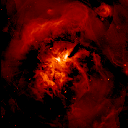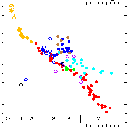


The second image is a Hertzsprung-Russell (HR) diagram for stars detected as radio sources. An HR diagram is one of the ways astronomers like to classify stars: temperature (increasing to the left) is represented on the bottom axis and intrinsic brightness is represented on the vertical axis. Thus hot bright stars appear in the upper left of this diagram and cool faint stars in the lower right.
If we put the Sun at the distance of the nearest star, we would not be able to detect it as a radio source, so the fact that so many stars are detected tells us immediately that they are doing something different from the Sun. The stars are color-coded, with the key to different types of stars given at the bottom of the image. Main sequence dwarf stars are ordinary cool stars similar to the Sun: they tend to be detected as radio sources if they are young and/or rapidly spinning. T Tauri stars are very young stars shortly after birth. The letters at the bottom of the figure show the ranges of different spectral types of stars. The filled symbols represent stars which appear to have "nonthermal coronae", that is, unlike the Sun where the outer atmosphere is mostly just heated up, in these stars the atmosphere is full of very energetic accelerated electrons which are responsible for the radio emission.
The third image is a comparison of radio and optical images of the planetary nebula BD+30deg 3639. Like LBVs (see another section on this home page for a description of these stars), planetary nebulae are stars which throw off their outer layers and produce spectacular nebulae, as in this object. However, the stars themselves are not particularly remarkable, unlike LBVs which are very massive. In this case the upper panel shows an image in a line of the element hydrogen taken with the Hubble Space Telescope (courtesy of Pat Harrington), while the lower panel shows a radio image at about the same resolution made with the Very Large Array radiotelescope in New Mexico. There are important differences between the two images: in the radio we see a much more complete ring of emission than we do optically. This is because there is dust mixed with the gas in this nebula, and the dust blocks visible light while being transparent to radio waves. Thus comparison of the two images shows us where the dust is located, and can tell us which side of the nebula is closest to us (the left side).